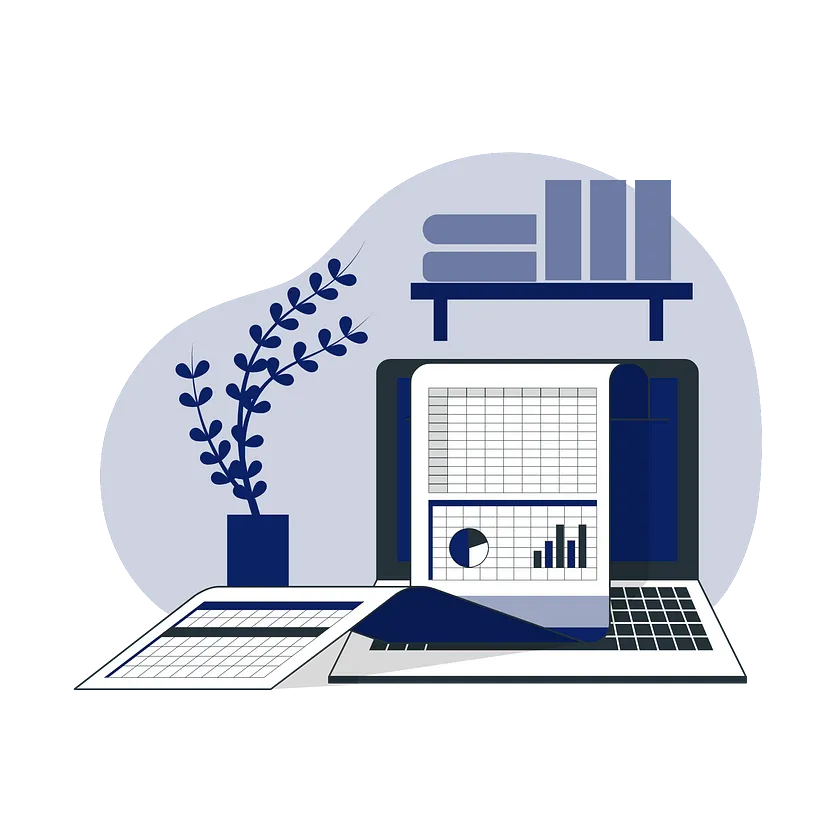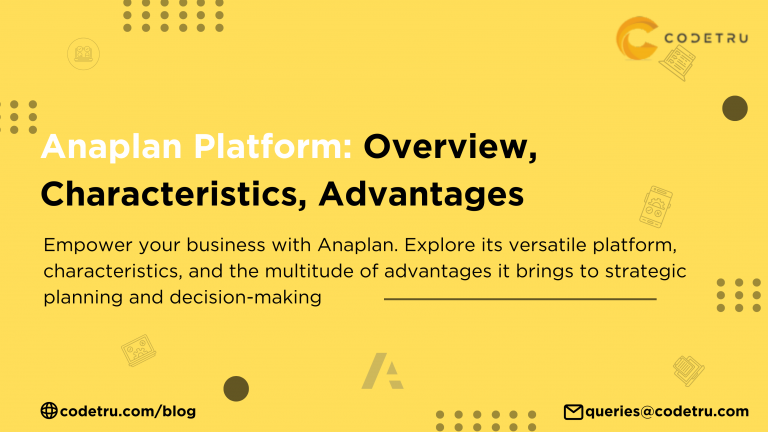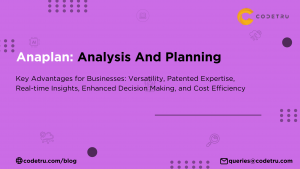Anaplan, which came from a combination of two words “analysis” and “planning,” is a comprehensive and robust organizational planning platform. It helps large organizations in making important, intelligent business plans and decisions by allowing them to collect and access significant business data easily.
This web-based enterprise platform for business planning is also known for its in-memory database and calculation engine called Hyper Block. By hyper-block, we mean, that when a customer enterprise uploads data to the Anaplan cloud, its users would be able to quickly organize and analyze disparate sets of enterprise data from finance, human resources, sales, and other areas of business operations.
Anaplan platform provides enterprise customers with familiar Excel-style functionality, and therefore, ordinary business users can use the software to make data-driven decisions that would otherwise require a data scientist’s skill set.
Anaplan incorporates modules for workforce force planning, quota planning, commission calculation, project planning, demand arranging, budgeting, planning and forecasting, monetary consolidation, and productivity modeling.
Key Characteristics of Anaplan Platform
Engaging User Experience
Anaplan’s cooperative, intuitive and engaging user experience carries the right individuals into the planning process at the right time, across devices and solutions. The whole organization will want to share continuous information, empower more brilliant and quicker decision-making, and uncommon adaptability.
With Anaplan:
- New and present-day design works with intuitive and customized insight across devices.
- One can build pages, apps, and boards to create more visual, interactive dashboards that display KPIs, charts, and many more.
- One can view KPIs, receive alerts, and make timely changes and updates easily.
- Commenting and sharing plans encourages teams to have contextual conversations about data and scenarios to quickly unify on strategy and execute.
- Extensions for Microsoft Office and Google Suite can enable a seamless experience online.
Embedded Intelligence
Embedded optimization includes optimizer, cutting-edge predictive algorithms, and evolving AI/ML capabilities that transform complicated inputs into actionable recommendations.

With embedded intelligence, one can access hundreds of variables and constraints, which lets optimization and ML capabilities solve for an optimal answer.
With embedded intelligence, one can derive recommendations for many complicated use cases that include sales territory planning, inventory management, project portfolio optimization, etc.
Further, embedded algorithms enable statistical forecasting such as Curve Fit, Smoothing, Seasonal Smoothing, and many more.
Powerful Planning & Modeling
Anaplan’s Hyperblock calculation engine enables multi-dimensional scenario modeling with unlimited constraints. This powerful technology allows companies to model the most complicated scenarios so that they can stay ahead of market changes. Meanwhile, Anaplan maintains 100% consistency across all model changes.
Anaplan offers two calculation engines — the Classic Engine and Anaplan Polaris TM. These engines are designed to solve any type of business problem at scale. Together, these engines empower businesses to easily expand plans and use cases alongside rapidly growing business needs.
In addition to this, HyperModel TM capabilities allow users to incorporate vast amounts of data into their use cases to solve complex business scenarios and naturally adjust forecasts.
Highly Extensible Ecosystem
Anaplan allows users to integrate and analyze data within a unified platform, thus, creating a single source of truth from planning to decision-making. APIs, ETL connectors, and built-in integrators easily communicate with other solutions.

Anaplan has connectors for ETL and ESB tools that integrate with systems of record, such as Informatica, MuleSoft, Dell Boomi, and SnapLogic.
Anaplan supports purpose-built integrations for enterprise systems of engagement — Tableau, Workiva, and DocuSign.
Anaplan can further be extended with custom integrations using REST APIs and scripting.
Enterprise Scalability
The Anaplan platform connects the whole enterprise and scales across trillions of cells, hundreds of models and use cases, thousands of users, and multiple versions. Calculations in Anaplan stay consistent and rapid for all data sets and any number of users.

Hyper-threading with CPU cores allows the Anaplan platform to process millions of rows per second.
Anaplan’s hyperblock technology processes only the relevant cells, dramatically reducing calculation time.
Application lifecycle management (ALM) in the cloud systematically synchronizes structure between models.
Robust Security
Anaplan platform has industry-leading security capabilities, thus, it gives businesses the transparency, visibility, access, and control needed for superior data safekeeping and protection. This platform offers best-in-class security and compliance including BYOK, single sign-on support with SAML 2.0, and data encryption at rest and in transit.

Identity and authorization management in Anaplan provides user management, access control, and selective access. Authentication is validated through SSO and certificates.
Encryption is kept at rest and in transit with an option for BYOK.
Audit functionality in the Anaplan platform tracks users’ activity and access control security events.
Advantages of the Anaplan Platform
Anaplan platform is software that analyses business performance data, which the decision-makers or managers can employ while moving forward. It generally covers enterprise-wide processes and single usages. With Anaplan, businesses and organizations can make sure that everyone involved in the decision-making process is on the same page.
Anaplan allows decision-makers to collaborate with ease, thus this results in a faster process of finding resolutions to issues at hand. Apart from these, there are a few more benefits that this platform offers.
Dynamic Planning
Dynamic planning is a collaborative process. The Anaplan platform allows for widespread participation in planning across the company and encourages feedback. This means you will have comprehensive information to continuously adapt plans as you can sense changes in the market.
Intelligent Decision Making
By choosing Anaplan, you can make smarter decisions across the whole business. This platform provides all the information you need to make intelligent choices whenever you need it. There aren’t any delays where you will have to wait to receive data that supports your decision.
Adapts Quickly
One of the best benefits of the Anaplan platform is that it quickly allows you to adapt to changes. You will be able to consider the possible options before responding in real time. This gives you and your organization access to everything you need. For example “Sonos” in an organization, drastically reduced the amount of time needed to respond to changes in demand.
Focus on Target
Scenario-based planning is important when you are making business decisions. For example “What if” scenarios that are possible with Anaplan, allow you to access what’s possible. This ensures you stay focused on the target because you can adjust accordingly when there is new information about the future like unexpected events, weather patterns, etc.
Boost Shareholder Confidence
Bad data is a risk; it can lead to bad decisions and blur the actual big picture, which can cause mistakes. Anaplan provides real-time data and therefore there is a no-longer risk that you have to worry about. Shareholders who earlier had reservations about incorrect data or the length of time taken to respond can now rest now because the Anaplan platform mitigates these risks.
Key Benefits of Anaplan for Different Business Functions
1. Finance
Streamlined Financial Planning
- Anaplan transforms the way finance teams handle budgeting and forecasting. With its powerful modeling capabilities, finance professionals can create dynamic financial models that adapt to changing market conditions, ensuring accurate and timely financial insights.
Enhanced Budget Management
- The platform simplifies complex budgeting processes by providing a unified view of financial data. This allows for more efficient resource allocation, reduces the time spent on manual data entry, and improves overall financial control.
Real-Time Financial Analysis
- Anaplan’s real-time data processing enables finance teams to analyze financial performance instantly. This means that decision-makers can quickly identify trends, assess financial risks, and make informed decisions based on up-to-date information.
2. Sales and Marketing
Optimized Sales Forecasting
- Sales teams benefit from Anaplan’s advanced forecasting tools that predict sales trends with greater accuracy. By analyzing historical data and market conditions, sales leaders can make more informed decisions about sales strategies and targets.
Effective Quota Planning
- Anaplan’s intuitive interface allows sales managers to set realistic quotas and track performance against targets. This helps in aligning sales efforts with business goals and ensures that the sales team remains focused and motivated.
Improved Marketing Spend Allocation
- Marketing departments can leverage Anaplan to optimize their spending by analyzing the ROI of different marketing channels. This ensures that marketing budgets are allocated efficiently, maximizing the impact of marketing campaigns.
3. Human Resources
Strategic Workforce Planning
- HR teams can use Anaplan to model various workforce scenarios, such as hiring needs, employee turnover, and salary adjustments. This helps in making strategic decisions about workforce management and planning for future talent needs.
Efficient Talent Management
- Anaplan supports talent management by providing insights into employee performance, compensation, and career development. This enables HR professionals to make data-driven decisions about promotions, succession planning, and talent development.
Cost Management and Optimization
- With Anaplan, HR departments can accurately model and forecast labor costs, ensuring that budgets are aligned with organizational goals. This helps in controlling expenses and optimizing overall compensation strategies.
4. Operations
Enhanced Project Planning
- Anaplan’s powerful modeling tools assist in managing complex projects by providing a clear view of resources, timelines, and deliverables. This helps project managers to plan effectively, track progress, and address issues before they become critical.
Improved Demand Planning
- Operations teams can leverage Anaplan to predict and plan for future demand. By analyzing historical data and market trends, businesses can ensure they have the right inventory levels and resources to meet customer needs.
Optimized Resource Allocation
- Anaplan’s planning capabilities enable operations managers to allocate resources more efficiently. This helps in balancing workloads, optimizing supply chains, and ensuring that resources are used effectively to achieve business objectives.
Conclusion
Anaplan stands out as a transformative platform that bridges the gap between strategic planning and operational execution across various business functions. By offering a robust combination of real-time data processing, advanced modeling capabilities, and seamless integration, Anaplan empowers organizations to make smarter, data-driven decisions.







